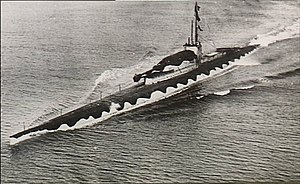British M class submarine

|
|
| Class overview | |
|---|---|
| Name: | M-class submarine |
| Builders: | Armstrong Whitworth, Vickers |
| Built: | 1916–1919 |
| In commission: | 1920–1932 |
| Planned: | 4 |
| Completed: | 3 |
| Cancelled: | 1 |
| Lost: | 2 |
| General characteristics | |
| Displacement: |
|
| Length: |
|
| Beam: | 24 ft 8 in (7.52 m) |
| Propulsion: |
|
| Speed: |
|
| Range: |
|
| Test depth: | 200 ft (61 m) - M2 accidentally reached 239 ft (73 m) in 1923 |
| Complement: | 62 |
| Armament: |
|
| Aircraft carried: | M2 converted to carry Parnall Peto seaplane |
The British Royal Navy M-class submarines were a small class of diesel-electric submarines built during World War I. The unique feature of the class design was a 12-inch (305 mm) gun mounted in a turret forward of the conning tower.
Due to the limitations imposed on submarine armament by the Washington Naval Conference, M2 and M3 had their guns removed. M2 was converted to carry a small seaplane and M3 was made into a minelayer.
They were ordered in place of the last four of the first group of steam-propelled K-class fleet submarines, K17-K21, the original orders being cancelled.
They were initially intended as coastal bombardment vessels, submarine monitors, but their role had been changed before detailed design begun. The intention was that merchant ships could be engaged at periscope depth or on the surface using the gun, rather than torpedoes. At that time torpedoes were considered ineffective against moving warships at more than 1,000 yards (900 m). A 12-inch gun fired at relatively short range would have a flat trajectory simplifying aiming, and few ships would be expected to survive a single hit.
The guns were 12-inch (305 mm) 40 calibre Mark IX guns from spares for the Formidable-class battleships. The mounting allowed them to elevate by 20 degrees, depress 5 degrees and train 15 degrees in either direction from the centre line. The weapon was normally fired from periscope depth using a simple bead sight on the end of the gun aligned with the target through the periscope at a range of around 1200 metres. The exposure time of the gun above the surface was around 75 seconds. The submarine had to surface to reload the gun, which would take about 3 minutes. In practice the concept was not very successful and only three of the four M-class boats ordered were completed, all between 1917 and 1918. M-class submarines are sometimes called submarine monitors.
M1 and M2 also had four 18-inch (450-mm) torpedo tubes whilst M3 and M4 had 21-inch (533 mm) diameter tubes and were 3 metres longer to accommodate them.
...
Wikipedia
